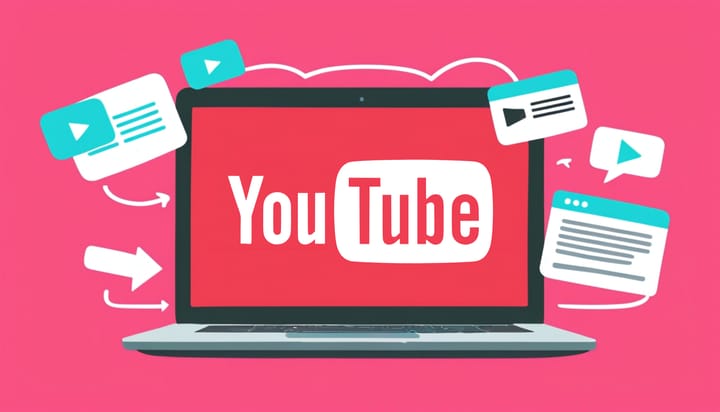Like, Comment, and Thrive: 8 Ways We Use YouTube for B2B Marketing
Our YouTube channel has nearly 200k subscribers, but does it actually matter? Here's an inside look at how we use YouTube to grow the business.

YouTube might (still) seem like a realm exclusive to music videos and shocking thumbnails (😱), but it's actually become a powerful channel for B2B marketing. It's time to update your perspective because we'd go even further: it's maybe the most important social media channel.
But can you even call YouTube a "social media" platform? I suppose that YouTube being hard to define is a major part of what makes it interesting—along with the 2.7 billion users that watch videos each month.
The way we use YouTube for B2B marketing reflects just how unique of a platform it is. While most companies—unfortunately—use their YouTube channel as little more than a dumping ground for any ol' video, our approach is much more deliberate.
And today, we're sharing our playbook: the main ways we use YouTube to drive measurable marketing results, and the approach we take for each opportunity.
How we use YouTube for B2B marketing
1. Reach more prospects and customers, full stop
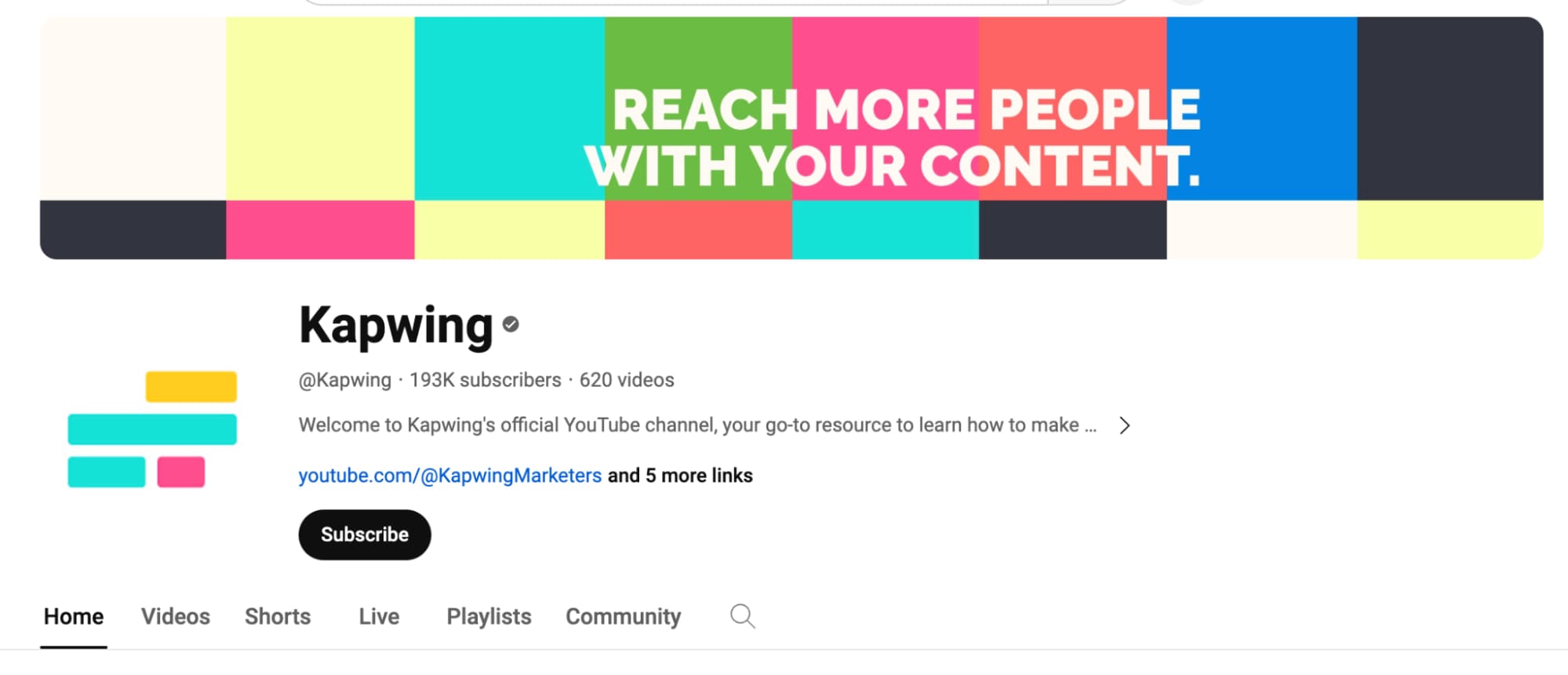
The main @Kapwing channel is visibly successful—millions of total views, hundreds of thousands of monthly views, and 193k subscribers—but does it really matter for the business?
Put simply, yes. YouTube is a top channel for Kapwing in terms of driving both qualified leads and paying customers, and that list includes naturally scaling channels like search and word of mouth which will likely always remain near the top.
YouTube's impact on our business stands out even more when compared to other channels. Although we've had viral success stories on other social media platforms, none have translated into the consistent, month-over-month impact on customer growth quite like YouTube. And when you look at the traffic source for these views (more on that in a second), it's clear these are mostly customers we wouldn't have been able to reach otherwise.
So although it might seem obvious to say, that's the first and most important way we use YouTube for B2B marketing: to drive revenue and tangible business results.
2. Get visibility for our content via YouTube search
YouTube's former Creator Liaison, Matt Koval, says that healthy channels generally get most of their views from Browse Features, Suggested Videos, and YouTube Search.
Based on the data for Kapwing's channel and my experience with channels like Learn with Shopify, I can say that B2B channels rely much more on YouTube search to earn views. In fact, over 50% of the monthly views for Kapwing's channel come from YouTube search directly.
And that's OK! It's a path toward YouTube growth that's far more steady-state and predictable. It also highlights a unique aspect of YouTube: although it's clearly a "social" oriented site where you share "media," it also has a heavily used search function that makes it operate similarly to a search engine.
The data on YouTube's role as a search engine is a bit muddy, but it's clear that YouTube search is a channel tens of millions of people default to. The most reliable data set we've seen is SparkToro's 2019 study that shows a breakout of market share for the top search engines in the US:
- Google Search: 68.81% market share, leading the pack by a large margin and only including standard web searches, as you'll see below.
- Google Image Search: 21.51% market share, if you spin out the image tab on Google as a separate search engine.
- YouTube Search: 3.09% market share, a distant third by also close to double that of the fourth and fifth place in Yahoo and Bing Search, respectively.
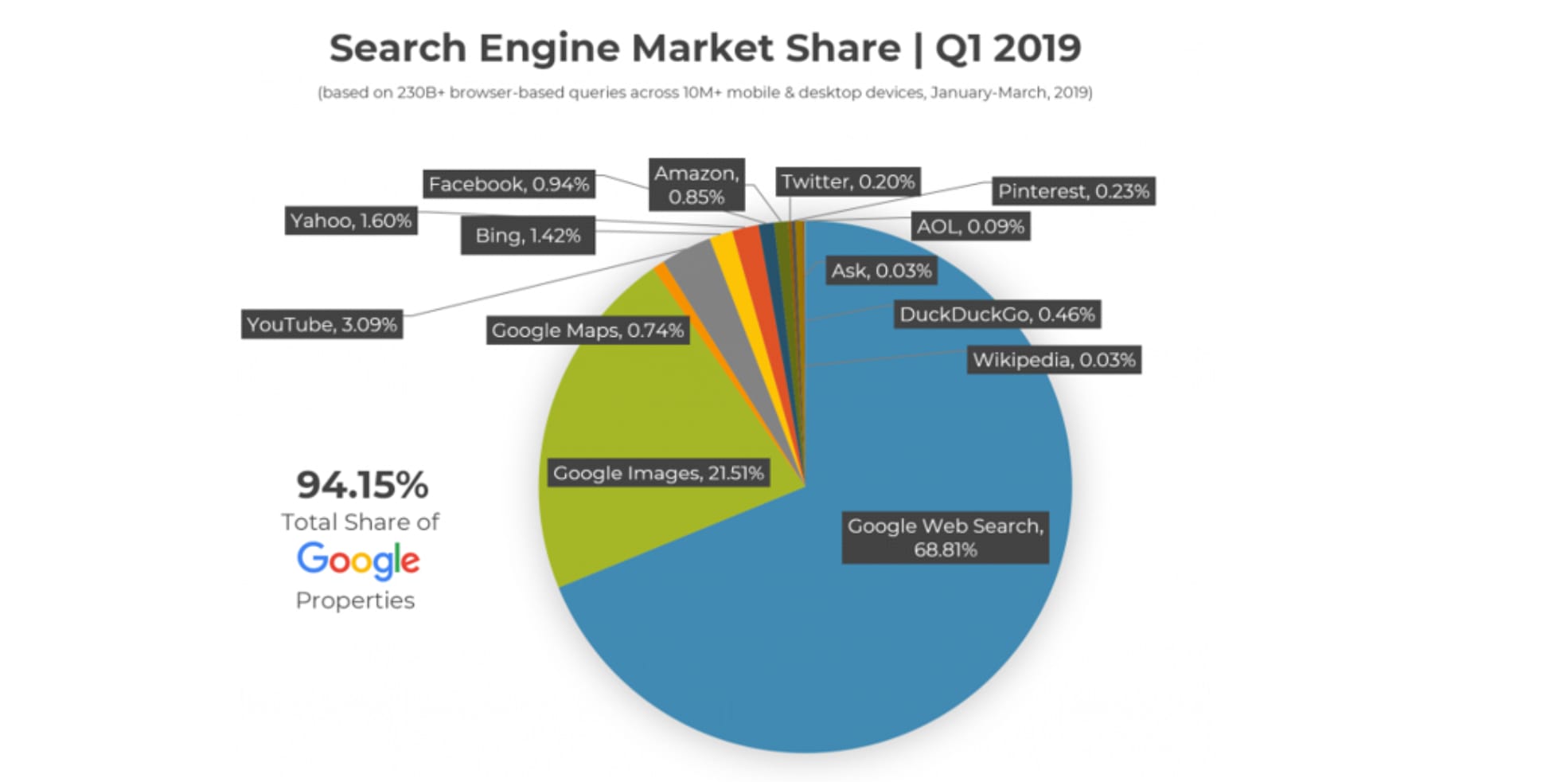
YouTube is also the most distinct in that list; Yahoo and Bing have similar experiences with different algorithms, and Google Images still includes mostly content from sites already featured in the web search. YouTube search is a bit of an island. When you look at YouTube this way, it's not unreasonable to see YouTube as part of your overall strategy for search—just on another platform.
For B2B marketers, this perspective can really work in your favor. Yes, you should experiment with story-driven and unapologetically bold video ideas for YouTube—those that will drive most of their views from recommended videos—but you can also build your day-to-day content calendar around what people are searching for right on YouTube.
We build our YouTube strategy around exactly this framework. Recently, we've begun measuring performance against "Views gained via YouTube search" specifically, and always structure a healthy portion of our content calendar around solving utilitarian questions that users might jump straight to YouTube for.
Reader beware: Keyword research for YouTube leaves a lot to be desired, so you'll mostly have to piece together opportunities using a mix of YouTube's suggested searches, keyword data from Google, and inbound keyword data—e.g., keywords that are driving views to your existing videos.
3. Create helpful tutorials that enhance our tools pages
Your YouTube strategy should fit your product and the way your business grows.
Kapwing, for example, has lots of use cases as a video creation platform, so we also have lots of landing pages to explain all of our features and workflows. These pages are also a significant source of traffic and customers for our business.
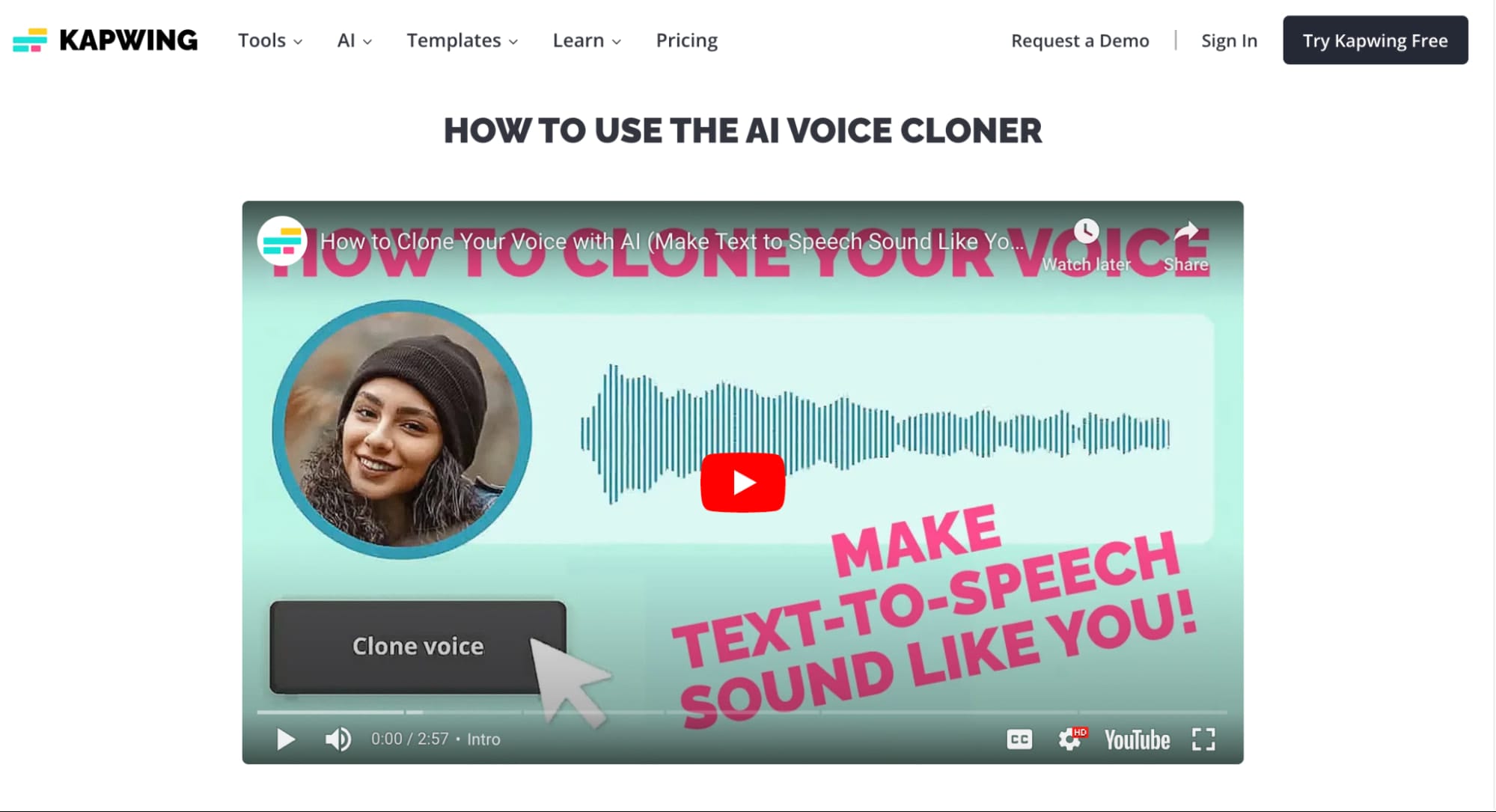
Not surprisingly, we feel these landing pages are made better by having a clear and helpful video tutorial to show you exactly how to solve that exact use case with Kapwing. For example, if you were to discover our Voice Cloning page, you'd also see a tutorial that shows you, step by step, everything you need to do to clone your voice.
We embed these videos on our site but, of course, also publish them to YouTube so they're discoverable there too. And the real trick is in making this content work for both channels. Or, creating a video that helps a user on the landing page but also fits our channel and caters to the algorithm.
This is a common theme with YouTube: you can "double-dip" with most of the content you make there so long as you're smart about the pairing. We accomplish this with our landing pages by framing all of our tutorials around achieving a certain outcome—the outcome is our hook, not the product or cut-and-dry tutorial.
Note that we do this because it fits our strategy for YouTube. This would be a very bad way to approach things if, for example, you run a channel that is goaled as a video help center for existing customers.
4. Get visibility for our content via Google Search
Any marketer who remembers the days when Google truly felt like "10 blue links" can also convey just how much the search engine results pages (SERPs) have come to favor multimedia content. Video is the premiere format—no surprise there—but just how prevalent is it?
That's a difficult question to answer, as it's very hard to get verifiable data. If you look at large data sets like Mozcast, it seems that at least 20% of search results contain video, whereas data from platforms like Advanced Web Ranking place the number closer to 35%. If we all agree that it's hard to know for sure, I'd say we can hazard a guess that video appears for 20-40% of searches globally.
OK, so video is a common format in the SERP. But you also have to add the (admittedly smaller) set of keywords that display with video intent, where Google is ranking a single video, a video snippet, or the Videos section broadly as the top result, even above all web pages. We see this a lot in our space.
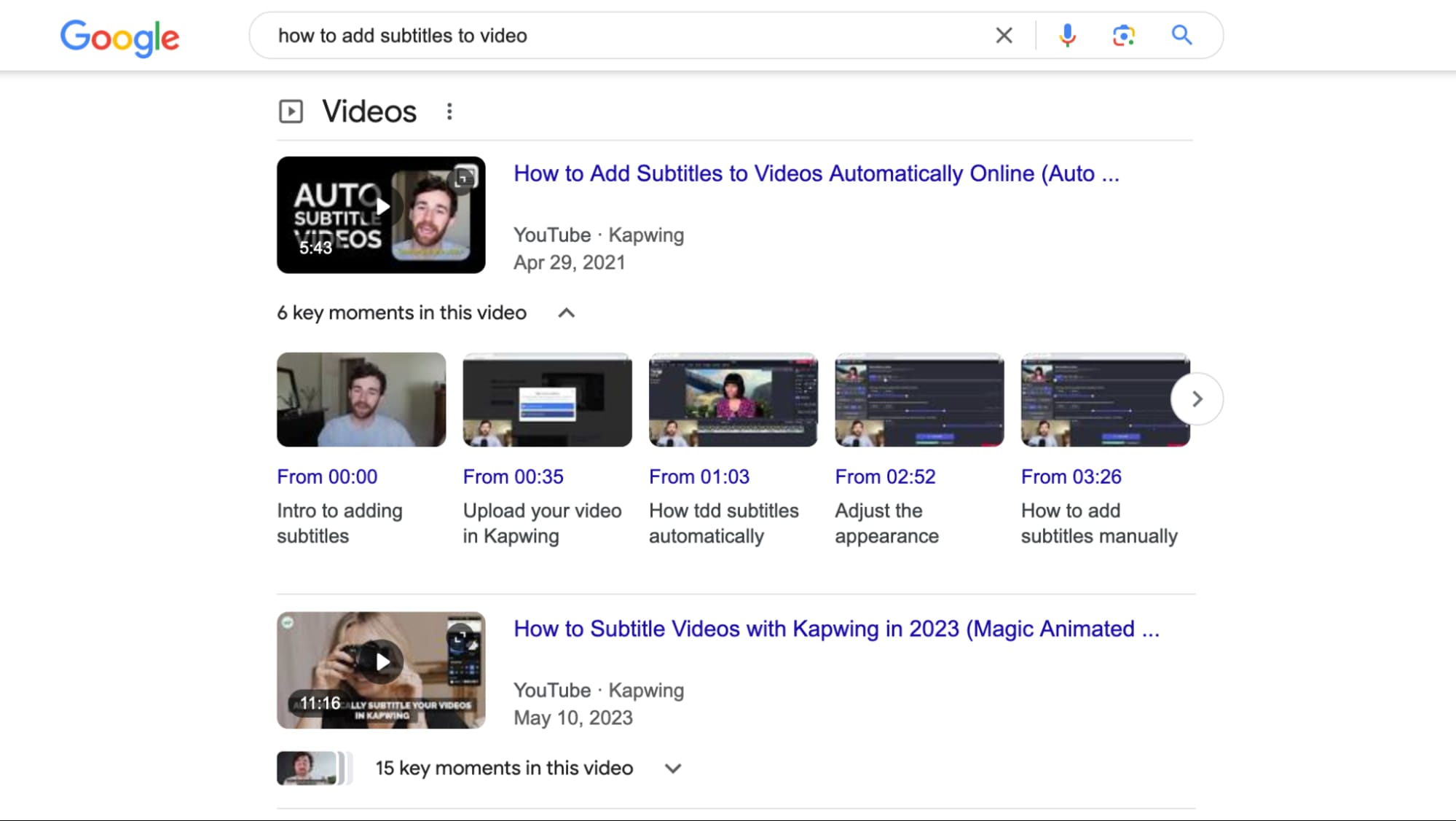
Like most businesses, of all the keywords we rank for there is an 80/20 power law at play: roughly 20% of the keywords drive the lion's share of the results in terms of the value they create for our business.
The right way to approach these keywords is to take a surround sound approach where you try to appear in every link you can—and that includes the Videos section. The great opportunity with the Videos section is that you aren't reliant on other publishers to get featured. The site in Position 2 may never agree to feature your product, but Videos is yours to rank for.
And to be clear, while there's much more to video SEO than just YouTube, let's get real: the vast majority of videos that appear on Google are YouTube videos.
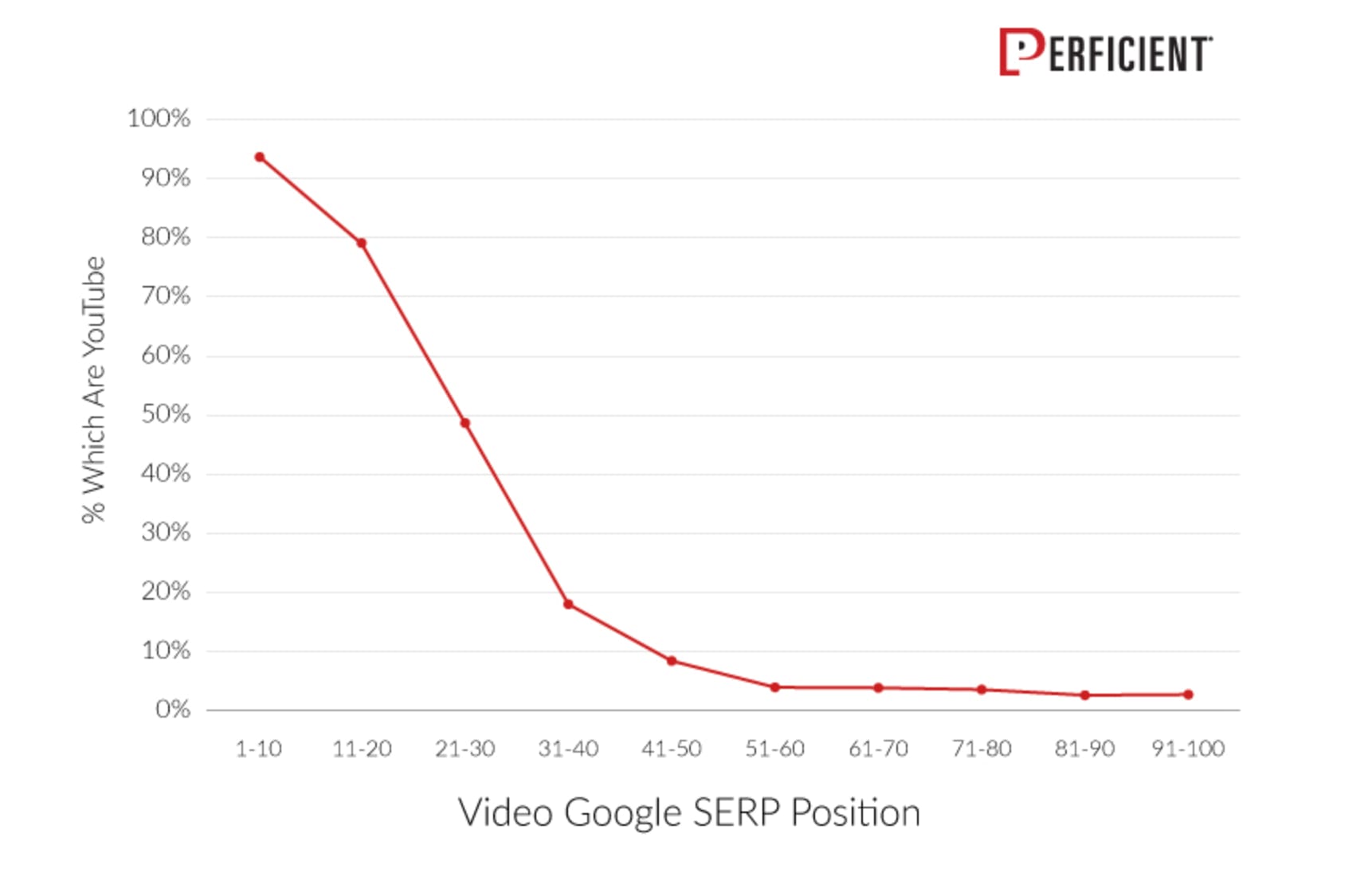
Perficient, a consultancy firm, published data that shows over 90% of videos that appear in the Top 10 position for a query are hosted on YouTube. No other video platform even comes.
Our approach is to create videos for terms that have clear video intent OR that seem to favor video, such as keywords where the SERP has the "Videos" section after Position 2/3. This way, we help solve for the intent on our actual web page and may also rank with the video we've paired with it.
5. Publish a video podcast that powers our social media
We believe one of the most overlooked podcast trends of our time is that YouTube will be the runaway success story for podcasting. That's why we're betting on YouTube today, even for our podcast.
We recently did an episode on why we're so bullish on YouTube for podcasts, but here's a quick summary:
- Better discoverability. YouTube is one of the world's best platforms for content discovery, and it's no surprise this has carried over to podcasts. Compare discoverability on YouTube (recommendations, search, visual thumbnails, etc.) versus any dedicated podcast platform and you'll see there really is no comparison.
- Repurposing is easier. Podcasts are notoriously hard to grow, so you're much more likely to see ROI if you're able to make video clips from your podcast to cross-post to other platforms where reach is far easier. As a bonus, you'll also fill your social media feed with content you're already making.
- More engaging for viewers. Survey data from Morning Consult shows the number one reason podcast fans say they prefer video to audio podcasts is to see the facial expressions and reactions of the hosts and guests. In general, video podcasts help you get familiar with the hosts and guests, too.
Let's not forget, YouTube is just plain popular for podcast listeners. In some ways, it's already the success story to watch in podcasting.
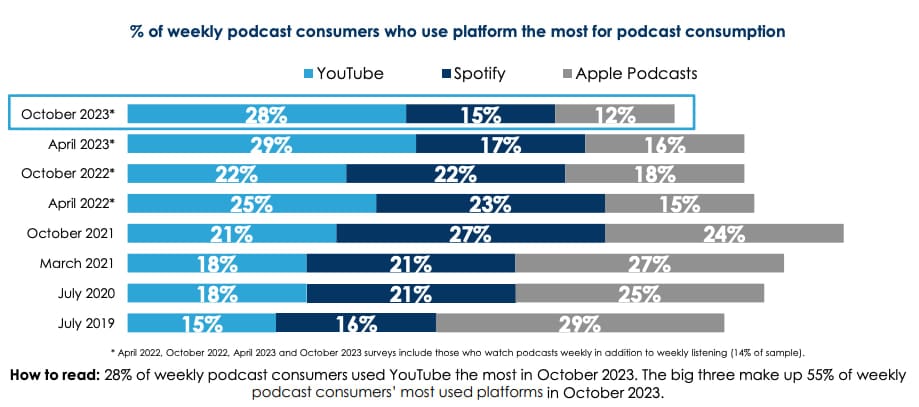
Cumulus Media and Signal Hill recently released a study that surveyed podcast listeners and found that 28% of weekly podcast listeners say they use YouTube the most for podcast consumption. That's more than the next two platforms—Spotify (15%) and Apple Podcasts (12%)—combined. And the preference for YouTube keeps growing.
The reasons to skip publishing your podcast on YouTube are slowly being patched up, too. YouTube is finally adding essentials like RSS for podcasts, while also adding tangential improvements like featuring podcasts in YouTube Music and the general opportunity present in Shorts as a place to post podcast clips.
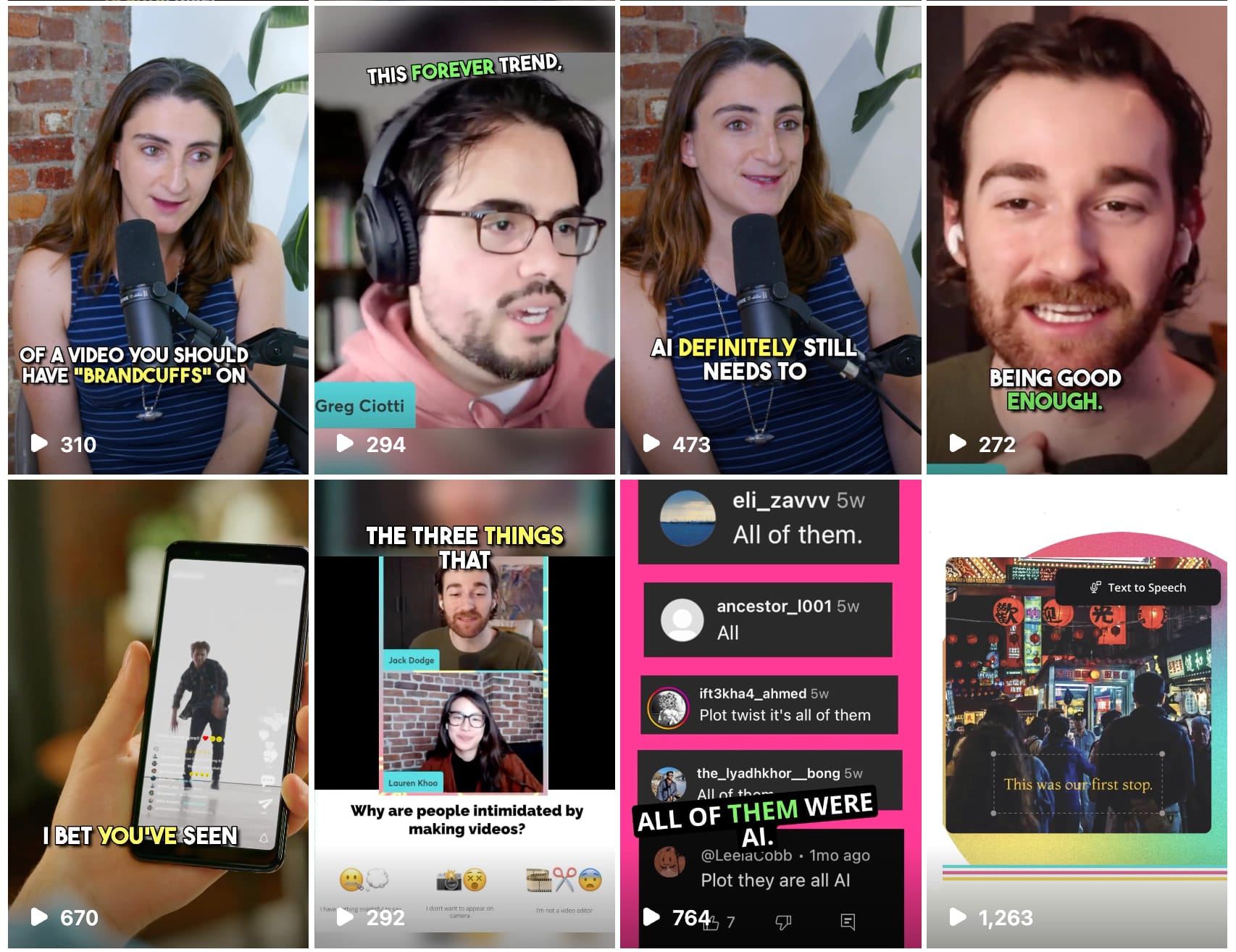
Our approach is to build discussion topics for our podcast based on customer interviews and market research, then use a tool like Repurpose Studio to quickly generate multiple clips based on the long-form video. If you haven't tried it before, Repurpose Studio is an AI-powered clip maker that quickly finds clips, centers speakers in frame, and resizes your video automatically.
These clips continue to play a key part in helping us build a consistent pulse on social media, and they're all created based on existing content.
6. Repurpose video content to power our SEO strategy
While products like Kapwing make it easy to turn a YouTube video into a blog post, we often see brands apply a much lazier approach to converting video to text than any other form of repurposing. While it's true that repurposing video content is a key way to unlock its full value, video → text is far different than video → video.
Text or editorial content is frequently going to find its best distribution from search, but unedited transcripts or basic summaries of your videos just aren't going to cut it in the current competitive landscape. Here's how we take our
- Create for the platform. We create our video content to fit our goals for YouTube or the series/content program broadly. We won't compromise a video by structuring it like a blog post if we feel like that won't perform well on YouTube.
- Find a relevant search query. To be clear, we mean a keyword for Google web search. Based on what the original video is about, brainstorm a few potential keywords that you think might be relevant to what you covered in the video.
- Use the video as the foundation. The critical step. Now, you can repurpose the YouTube video by using it as the foundation for the written piece you want to create to rank for the keyword you uncovered. That means taking the core ideas and mapping out which ones are relevant to the search intent on the web-based keyword.
- Expand, subtract, or change. Here's where the winners separate themselves. With your video as a starting point, look at the search intent for the term by seeing what Google is already rewarding. Do all of the pages list examples? How about tool recommendations? What's missing from your original video that needs to be added to the article, or what feels unrelated?
We often turn our videos into editorial content, but only after tailoring the material to perform well as text.
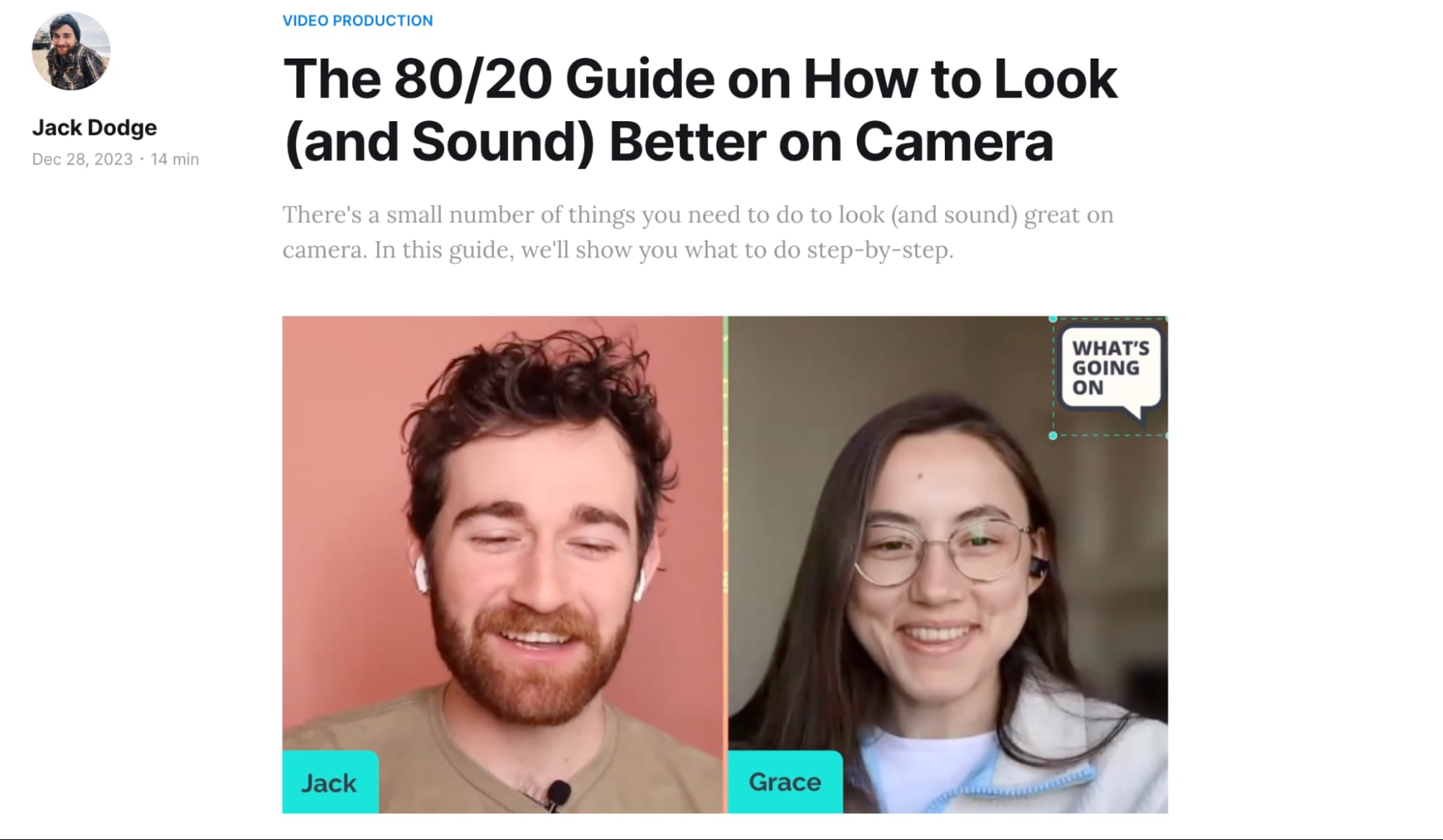
For example, we did a podcast on the 80/20 rules of looking better on camera. Then we found a keyword for that topic, used our conversation as the heart of the article, but added extra sections that were superfluous for the podcast but required to fulfill the searcher's intent (e.g., more gear recommendations). That led to a blog post that feels indiscernible from one we'd create from scratch, and a page primed to rank in search.
Our last bit of advice is to pair the videos you'll repurpose with certain groups of search-driven content. At Kapwing, for example, we rarely repurpose YouTube videos to serve as pillar pages for highly-competitive search terms (e.g., "video marketing"). That's because these pages often need to be very long to fulfill the search intent, and it's much easier to start with the article in that case.
But for less competitive keywords with shorter text requirements, YouTube videos serve as a great source of content to repurpose.
7. Announce brand-new products and features
This might seem like an obvious use case for YouTube, but stay with me. Since we've grown our YouTube audience to 200k subscribers, YouTube also serves as a valuable launchpad for making product announcements—but we approach the opportunity in a very deliberate way.
The very worst use of YouTube in B2B marketing is creating a brand channel that serves as little more than a dumping ground for video. We've seen many of these "video graveyards" and it's the leading cause in marketers valuing YouTube as a distribution channel.

If you want to grow your audience, it's best to look at YouTube as a content discovery platform, not a video hosting platform. That means your presence on YouTube needs to resemble an editorial or social content strategy with the same standards for quality and consistency. Any video published to your channel should feel like it fits the purpose and audience of your channel.
We make that happen by orienting our product announcements on the main Kapwing channel around solving important use cases; we'd want to publish these videos even if we didn't have a feature to announce. It's tricky making this work sometimes, but prioritization is painful and we choose to prioritize our reach on YouTube over the ease of just uploading any old feature announcement.
If you absolutely cannot make something similar work, there's nothing stopping you from creating two YouTube channels and deliberately making one of them "the general-purpose channel," or the place where you upload videos without dedicated goals for growth. Just don't let that become your only channel if you want YouTube to have an actual impact.
8. Improve key editorial content with embedded video
We mentioned before that when you look at self-attribution, search over-performs as a channel for Kapwing. HockeyStack recently released a report that shows this seems to be true for most B2B companies. The death of search, it seems, has been greatly exaggerated.
But as we've said many times on this blog, our podcast, and, of course, our YouTube channel, all search-informed content is getting more competitive. To edge out the competition in terms of how user-focused your content is—how deeply it solves the user's problem—you often have to go multimedia.
Read as: Don't just tell me how to solve a problem in the text, show me. This goes beyond keyword research or performance on YouTube itself: creating YouTube videos to help make your editorial pages flat-out better is a worthy effort in itself. Just make sure that the final product fits your YouTube channel, too.
There are examples of this littered across our blog and on this very page. Once again, we can also look at how prominently Google features videos in any given query—if video is featured anywhere in the top 5 results, searchers are basically crying out for any web page featured to have a video paired with the editorial content. Even when the YouTube video is a 1:1 retelling of the written content, some people just prefer the visual format.
We're all-in on YouTube
We've tried many experiments with video last year and will attempt many more. But it became clear that we're unlikely to find a channel as consistently impactful as YouTube—and there's perhaps no channel with so much room to grow.
Tag along with our blog or our new behind-the-scenes channel, Kapwing for Marketers, as we continue to decode growth on YouTube.
Create content faster with Kapwing's online video editor →

